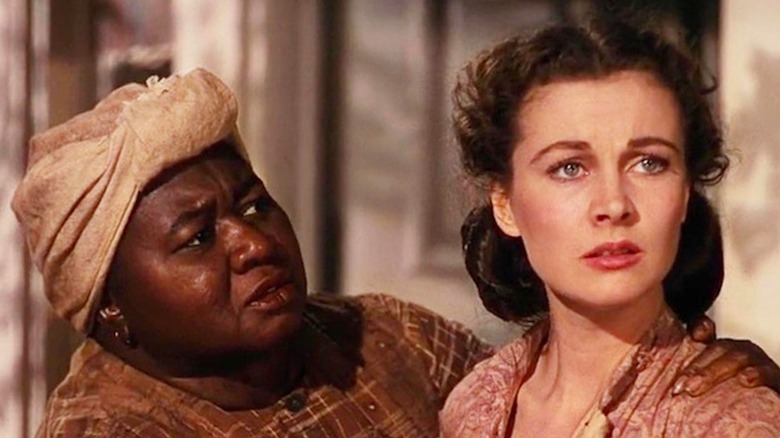This Controversial Historical Epic Streaming On HBO Max Is A Classic (And A Tough Watch)
David O. Selznick's epic film production of Margaret Mitchell's novel "Gone with the Wind" is, adjusted for inflation, the highest-grossing movie in the history of the medium. It is iconic, unruly, and enormously entertaining. It is also undeniably racist and worthy of scorn. And this is why it cannot be easily swept into the dustbin of Bad Art.
Film scholars and cultural critics have been reckoning with "Gone with the Wind" for many decades, as they must consider the crater-sized imprint the movie has left in the American cultural landscape. I am 52 years old, and have watched the Civil War-set film plummet from beloved must-see to something that cannot be aired or streamed without an introduction warning viewers that they are about to bear witness to a horrendously dated artifact from a profoundly unenlightened age. When the American Film Institute held its last poll of the 100 greatest American movies ever made in 2007, "Gone with the Wind" finished sixth overall. If they were to conduct a new poll today, I am quite certain that the film would not chart at all.
My own views on the film have evolved over the years. At one point, I was inclined to examine why the movie, which is told from a Confederate point of view, had stood the test of time rather than dig into its obviously problematic qualities because, I reasoned, that issue was settled. Also, sorry dril, I decided you had to hand it to Selznick because he'd jettisoned the Ku Klux Klan, which figured prominently in Mitchell's novel.
While I do not feel the need to revisit "Gone with the Wind" nowadays (I've seen it several times), I support HBO Max's decision to stream it with an introduction for a variety of reasons.
Gone with the Wind is an awe-inspiring filmmaking achievement
Published in 1936, Margaret Mitchell's Gone with the Wind became a national sensation—and perhaps the first bestseller that had readers immediately dreaming of its film version. Newspapers polled fans on who should play the bratty protagonist Scarlett O'Hara and charming rogue Rhett Butler. Producer David O. Selznick only wanted Clark Gable for Rhett, but he turned Scarlett's casting into a marketing spectacle, giving audiences an emotional stake in the movie before a single frame was shot.
Though "Gone with the Wind" was released on December 15, 1939, due to the roadshow release strategy (which found the film playing special engagements in large markets for an elevated admission price), the vast majority of Americans would not see it in a movie theater until almost two years later. During that time, they feverishly imagined how the 1939 Best Picture winner would look and sound, and, amazingly, once it finally played in their area, the damn thing exceeded their expectations.
Selznick, ever the perfectionist, spared no expense adapting Mitchell's sprawling novel. To secure Gable, he had to cut MGM into the production. He fired director George Cukor early on and pushed his replacement, Victor Fleming, so relentlessly that Fleming had to step away for exhaustion. In truth, production designer William Cameron Menzies had more influence over the film's look than either director. Yet Selznick pulled it all together, emphasizing pace over artistry. That might be "Gone with the Wind's" most impressive technical feat: editorially, it's rough-hewn, but through sheer filmmaking showmanship, it flies by.
At least it did the last time I watched it. I'd be way less charitable to the actual material of the movie today.
The case for watching Gone with the Wind in 2025
For well over 60 years, we were held prisoner by conventional wisdom, which decreed that "Gone with the Wind" was an inarguable classic. If anyone ever spoke out about its portrayal of slavery, they were sternly reminded that Hattie McDaniel's portrayal of the sassy/subservient Mammy earned her the Academy Award for Best Supporting Actress, the first ever won by an African-American performer.
But the film's vision of Reconstruction as a hardship for Vivien Leigh's Scarlett to overcome, rather than a means to subject freed slaves to a mutant form of systemic slavery, is... not ahistorical, but plenty infuriating. Leigh is so incandescently magnificent as Scarlett that we lose sight of how selfish and psychologically abusive she is. That it takes an act of marital rape via Rhett to knock her down a peg is all the more atrocious.
"Gone with the Wind" is a ball of glossed-over awfulness, and I completely understand if you'd rather read the scholarship than watch the movie. But it's worth keeping in mind that this is a sanitized version of a much more racist book, and, unlike D.W. Griffith's equally significant and racist "Birth of a Nation," it doesn't aggressively push the cause of white supremacy. This is what enlightenment looked like in 1939, and for a strangely long time — throughout the Civil Rights Movement, after the murders of Chaney/Goodman/Schwerner, four little girls in Alabama, Malcolm X, and Martin Luther King Jr. — America held this up as the apogee of motion picture excellence. "Gone with the Wind" looms large in our cultural legacy, and we must reckon with it.
Pretending we weren't once these people has only resulted in a chunk of our population becoming these people again.


